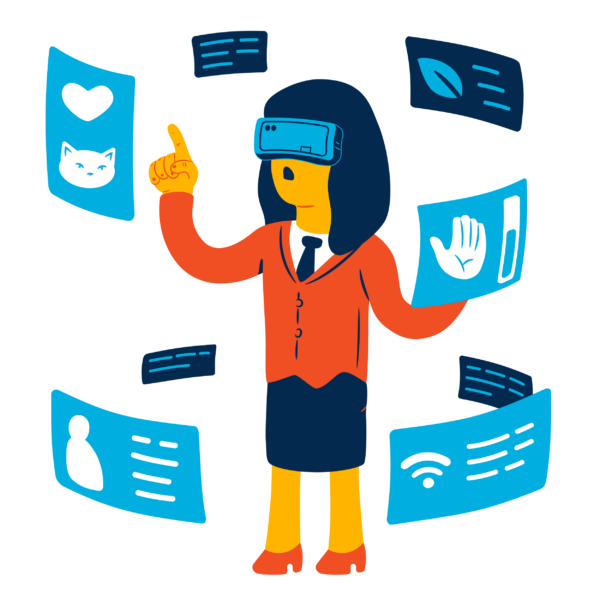
Virtual Reality (VR) is the future of onboarding
Virtual Reality (VR) is a three-dimensional computer-generated simulation wherein users can interact with the environment with special equipment to experience a seemingly real situation. Set for explosive growth, VR is projected to grow into a USD 20.9 billion industry by 2025. This growth is fuelled by the availability of advanced technologies, growing use of head-mounted devices (HMD) for display in different industries, the availability of VR devices and huge investments in VR.
The COVID-19 pandemic has also accelerated the use of VR across industries and functions. With businesses having undergone an extreme digital transformation and adopting a “can-do” attitude, VR is no longer an imagined future. In the workplace, VR is increasingly being used by corporates in human resource interactions, especially in training and onboarding. The recent shortage of skills, the ongoing talent war and the Great Resignation mean that employers need to find the best strategies to engage with employees. When it comes to new recruits, a robust onboarding programme can result in a positive employee experience.
The importance of onboarding
According to a study, over 90 per cent of employees decide to stay or quit within the first six months of joining the organisation. Enterprises are trying to find the best way to engage with new employees and provide immersive experiences.
Onboarding provides new employees a jumpstart to becoming productive and valued contributors to the business. An onboarding programme needs to be relevant and engage with employees as quickly as possible to ensure they feel comfortable both with the organisation’s culture and their new role. Gen Z has higher expectations of employers and needs to be engaged from day one of employment. An effective onboarding programme helps build employee connections, increases efficiency and engages the new employee while building the employer brand.
Employee onboarding reimagined
There are a multitude of ways in which VR can enhance the onboarding experience.
Although it may seem unlikely, VR can help forge personal connections for new employees. Employees who are working remotely especially stand to benefit from a VR onboarding experience. VR can be used to organise “meet-ups” during virtual onboarding. For instance, Accenture has a new digital hire campus, which has an “Nth” floor, a virtual water cooler area for employees to catch up.
Using VR during onboarding can create a “wow” factor for new employees. Gamification can be used to make tedious HR processes and seminars more interesting and effective. Employees can be taken on a personalised, immersive tour of the campus, meet key people and imbibe company culture. IKEA has used VR to introduce new employees to their work culture.
New employee training is a critical element of onboarding. With remote and hybrid working models, live training is an even more expensive and time-consuming proposition. While e-learning has been a popular choice so far, it is not “action-oriented”, and companies are increasingly turning to VR training, which offers flexibility, interaction and immersive experiences. The session can be recorded once and played back many times.
VR training provides employees with a more realistic, relatable and memorable experience as compared to other media such as instruction manuals or video tutorials. Using VR for training people on jobs that require movement and muscle memory, such as on factory floors, has proven to be more effective than the traditional methods of learning. The repetitive movements during VR forge neural connections that lead to endured learning. Walmart uses VR training to recreate scenarios that may occur on sales floors, say, for example, rush hour during the Black Friday sale. They are also using VR to train employees on soft skills and new technology. Fidelity Investments Inc. has used VR to train new hires on empathy.
Using VR during onboarding results in cost savings, increased efficiency and better resource utilisation while not compromising on employee experience and training outcomes. Organisations can assess the new employees’ skills during training, and even predict how they will do their job, based on their training scores. This provides a quantitative way to assess the effects of learning.
While VR has the potential to transform the onboarding process, the cost of VR headsets and the investment in VR training are challenges that need to be surmounted for wide-scale adoption. There are security and privacy concerns as well. Additionally, new hires with visual or hearing impairments may not be comfortable with VR-enabled modules. The integration of VR with onboarding will need to be aligned with business objectives. The organisation should identify an experienced partner and implement the technology where it is most effective. While not a substitute for human interaction, VR can be used to create a highly impactful onboarding experience.
References:
- https://www.forbes.com
- https://www.researchandmarkets.com
- https://www.techtarget.com
- https://workology.com
- https://www.spiceworks.com
- https://www.rootinc.com
- https://www.myjoining.in
- https://www.strivr.com
- https://gadgets360.com
- https://corporate.walmart.com
- https://www.shrm.org/resourcesandtools
- https://www.i4cp.com